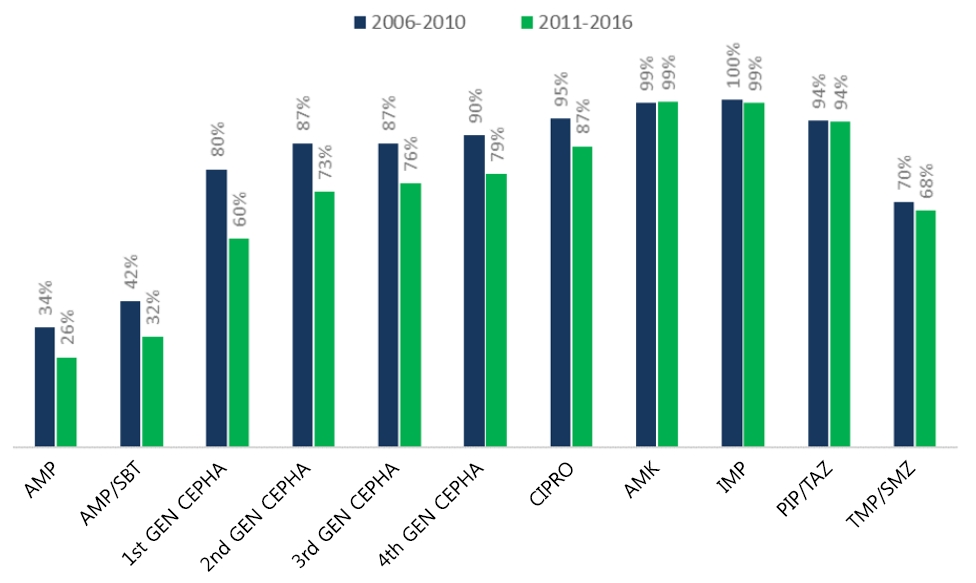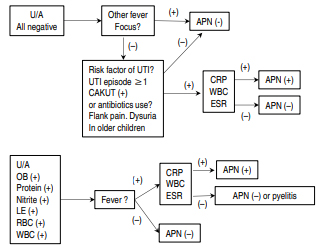Search
- Page Path
-
- HOME
- Search
- Original Article
- Nephrology (Genitourinary)
- Urinary neutrophil gelatinase-associated lipocalin: a marker of urinary tract infection among febrile children
- Ji Hyun Moon, Kee Hwan Yoo, Hyung Eun Yim
- Clin Exp Pediatr. 2021;64(7):347-354. Published online October 17, 2020
-

Question: Reliably diagnosing urinary tract infection (UTI) in febrile children is often difficult. Can urinary neutrophil gelatinase-associated lipocalin (uNGAL) better predict UTI and acute pyelonephritis (APN) than serum C-reactive protein (CRP) and white blood cell (WBC) count?
Finding: uNGAL better facilitated the prediction of UTI and APN, than serum CRP and WBC counts in febrile children.
Meaning: uNGAL is a suitable biomarker for UTI and APN in febrile children.
- Infection
- Febrile urinary tract infection in children: changes in epidemiology, etiology, and antibiotic resistance patterns over a decade
- Woosuck Suh, Bi Na Kim, Hyun Mi Kang, Eun Ae Yang, Jung-Woo Rhim, Kyung-Yil Lee
- Clin Exp Pediatr. 2021;64(6):293-300. Published online October 14, 2020
-

Question: How has the antibiotic susceptibility of urinary pathogens changed and what does it imply?
Finding: A yearly increase in multidrug-resistant and extended-spectrum β-lactamase (ESBL)–producing pathogens was observed. A higher recurrence rate was observed in cases of febrile urinary tract infection caused by ESBL producers in patients with underlying vesicoureteral reflux (VUR).
Meaning: The initial empirical antibiotic should reflect the changing susceptibility patterns and underlying VUR status.
- Review Article
- Nephrology (Genitourinary)
- Reconsideration of urine culture for the diagnosis of acute pyelonephritis in children: a new challenging method for diagnosing acute pyelonephritis
- Jun Ho Lee, Seonkyeong Rhie
- Clin Exp Pediatr. 2019;62(12):433-437. Published online October 18, 2019
-

Acute pyelonephritis (APN) should be detected and treated as soon as possible to reduce the risk of the development of acquired renal scarring. However, in the medical field, urine culture results are not available or considered when the prompt discrimination of APN is necessary and empirical treatment is started. Furthermore, urine culture cannot discriminate APN among children with febrile urinary...
- Case Report
- Neurology
- Mild encephalopathy with a reversible splenial lesion in a girl with acute pyelonephritis
- Jung Sook Yeom, Chung Mo Koo, Ji Sook Park, Ji-Hyun Seo, Eun Sil Park, Jae-Young Lim, Hyang-Ok Woo, Hee-Shang Youn
- Clin Exp Pediatr. 2018;61(2):64-67. Published online February 28, 2018
-
We report the case of a 12-year-old girl who had mild encephalopathy with a reversible splenial lesion (MERS) associated with acutepyelonephritis caused by
Escherichia coli . The patient was admitted with a high fever, and she was diagnosed with acute pyelonephritis based on pyuria and the results of urine culture, which detected cefotaxime-sensitiveE. coli . Although intravenous cefotaxime and tobramycin were...
- Original Article
- Nephrology (Genitourinary)
- Usefulness of neutrophil-lymphocyte ratio in young children with febrile urinary tract infection
- Song Yi Han, I Re Lee, Se Jin Park, Ji Hong Kim, Jae Il Shin
- Clin Exp Pediatr. 2016;59(3):139-144. Published online March 31, 2016
-
Purpose Acute pyelonephritis (APN) is a serious bacterial infection that can cause renal scarring in children. Early identification of APN is critical to improve treatment outcomes. The neutrophil-lymphocyte ratio (NLR) is a prognostic marker of many diseases, but it has not yet been established in urinary tract infection (UTI). The aim of this study was to determine whether NLR is a...
- Case Report
- Urosepsis and postrenal acute renal failure in a neonate following circumcision with Plastibell device
- Meena Kalyanaraman, Derrick McQueen, Joseph Sykes, Tej Phatak, Farhaan Malik, Preethi S. Raghava
- Clin Exp Pediatr. 2015;58(4):154-157. Published online April 22, 2015
-
Plastibell is one of the three most common devices used for neonatal circumcision in the United States, with a complication rate as low as 1.8%. The Plastibell circumcision device is commonly used under local anesthesia for religious circumcision in male neonates, because of cosmetic reasons and ease of use. Occasionally, instead of falling off, the device may get buried under...
- Original Article
- Serum levels of interleukin-6 and interleukin-8 as diagnostic markers of acute pyelonephritis in children
- Abolfazl Mahyar, Parviz Ayazi, Mohammad Reza Maleki, Mohammad Mahdi Daneshi-Kohan, Hamid Reza Sarokhani, Hassan Jahani Hashemi, Mousa Talebi-Bakhshayesh
- Clin Exp Pediatr. 2013;56(5):218-223. Published online May 28, 2013
-
Purpose Early diagnosis and treatment of acute pyelonephritis in children is of special importance in order to prevent serious complications. This study was conducted to determine the diagnostic value of serum interleukin (IL)-6 and IL-8 in children with acute pyelonephritis.
Methods Eighty-seven patients between 1 month to 12 years old with urinary tract infection (UTI) were divided into 2 groups based on the...
- Discordant findings on dimercaptosuccinic acid scintigraphy in children with multi-detector row computed tomography-proven acute pyelonephritis
- Jeongmin Lee, Duck Geun Kwon, Se Jin Park, Ki-Soo Pai
- Clin Exp Pediatr. 2011;54(5):212-218. Published online May 31, 2011
-
Purpose The diagnosis of acute pyelonephritis (APN) is often difficult, as its clinical and biological manifestations are non-specific in children. If not treated quickly and adequately, however, APN may cause irreversible renal damage, possibly leading to hypertension and chronic renal failure. We were suspecting the diagnostic value of 99mTc-dimercaptosuccinic acid (DMSA) scan by experiences and so compared the results of DMSA...
- Limitations of 99mTc-DMSA scan in diagnosing acute pyelonephritis in children
- Byung Gee Kim, Jae Ryoung Kwak, Ji Min Park, Ki Soo Pai
- Clin Exp Pediatr. 2010;53(3):408-413. Published online March 15, 2010
-
Purpose : We aimed to prove the relative limitation of 99mTc-DMSA scintigraphy (DMSA) compared to computed tomography (CT) in diagnosing acute pyelonephritis (APN) in children. Methods : Since September 2006, after a 64-channel CT was imported, 10 DMSA false-negative patients have been identified: these patients underwent a CT scan for acute abdomen or acute febrile symptoms and were diagnosed as... -
- Urinary tract infections in infants under six months of age
- Min Joo Kang, Hye Kyung Shin, Hyung Eun Yim, Bo-Kyung Je, So Hee Eun, Byung Min Choi, Jong-Tae Park, Baik Lin Eun, Kee Hwan Yoo
- Clin Exp Pediatr. 2006;49(3):278-286. Published online March 15, 2006
-
Purpose : Although suprapubic bladder aspiration(SBA) is the most reliable technique for identifying bacteriuria in young infant, no report has been published about the clinical manifestations of urinary tract infection(UTI) diagnosed by aspirated urine in Korea. This study was performed to examine clinical manifestations and related factors of UTI confirmed by a positive urine culture obtained by SBA in young infants. Methods : We reviewed... -
- Usefulness of serum procalcitonin test for the diagnosis of upper urinary tract infection in children
- Dong Wook Kim, Ju Young Chung, Ja Wook Koo, Sang Woo Kim, Tae Hee Han
- Clin Exp Pediatr. 2006;49(1):87-92. Published online January 15, 2006
-
Purpose : It is difficult to make a distinction between lower urinary tract infection(UTI) and acute pyelonephritis(APN) during the acute phase of febrile UTI due to nonspecific clinical symptoms and laboratory findings, especially among young children. We measured the serum procalcitonin(PCT) in children with UTI to distinguish between acute pyelonephritis and lower UTI, and to determine the accuracy of PCT... -
- Risk Factors of Renal Scar After Acute Pyelonephritis in Children
- Chur Woo You
- Clin Exp Pediatr. 2001;44(1):54-61. Published online January 15, 2001
-
Purpose : In this study we re-evaluated the known risk factors of pyelonephritic scarring in children. Methods : A prospective study was performed on 36 acute pyelonephritis(APN) patients who were diagnosed as first acute pyelonephritis on 99mTc-DMSA scan between September 1998 and March 2000 in Masan Samsung Hospital. According to the prescence of remnant lesions on the 99mTc-DMSA scan performed... -
- Changes in the Findings of 99mTc-dimercaptosuccinic Acid(DMSA) Scan after Acute Pyelonephritis in Childhood and Renal Scar
- Sang Hee Ahn, So Young Yoon, Chong Hyun Yoon, Dae Hyuk Moon, Young Seo Park
- Clin Exp Pediatr. 2000;43(4):543-549. Published online April 15, 2000
-
Purpose : We evaluated the change in the findings of DMSA scan after acute pyelonephritis (APN), and the relationship between renal scar formation and risk factors such as vesicoureteral reflux(VUR), organism and inflammatory reaction. Methods : We examined 200 patients under the age of 5 years with first APN. DMSA scan, voiding cystourethrography(VCUG), erythrocyte sedimentation rate(ESR) and C-reactive protein (CRP) were... -
- The Risk Factors of Renal Scar in Childhood Acute Pyelonephritis
- Soo Ja Hwang, Seung Joo Lee
- Clin Exp Pediatr. 1999;42(4):545-552. Published online April 15, 1999
-
Purpose : To observe the risk factors of renal scar in children with first acute pyelonephritis (APN) who had photopenic defects on initial 99mTc-DMSA spect renal scan. Methods : Forty-seven children with first APN(M : F=33 : 14) who were admitted to Ewha Womans University Hospital from September, 1993 to Febrary, 1998, were divided into renal scar group(N=17, Kidney unit(KU)=18) and... -
- Diagnostic Value of 99mTc-DMSA Renal Scan for Early Diagnosis of Acute Pyelonephritis in Children with Febrile Urinary Tract Infection
- Soo Ja Hwang, Eun Ae Park, Jeong Wan Seo, Seung Joo Lee, Sun Whan Lee
- Clin Exp Pediatr. 1996;39(11):1586-1593. Published online November 15, 1996
-
Purpose : For prevention of renal scar, early diagnosis and treatement of acute pyelonephritis are important in children with febrile urinary tract infection. But it has been difficult to differentiate acute pyelonephritis from lower urinary tract infection. We have performed this study to evaluate the diagnostic value of 99mTc-DMSA renal scan and to clarify the relationship among acute pyelonephritis, vesico-ureteral reflux and renal scar. Methods... -
- Case Report
- A Case of Xanthogranulonatous Pyelinephritis with Idiopathic Hypercalciruia in a Child
- Young Jun Kim, Hyun Joo Kwak, Keun Haeng Cho, Kee Hwan Yoo, Young Sook Hong, Soon Kyum Kim
- Clin Exp Pediatr. 1994;37(12):1778-1783. Published online December 15, 1994
-
Xanthogranulomatous pyelonephritis in childhood is a rare chronic pyelonephritis often assodiated with calculi of urinary tract obstruction, with a clinical presentation of renal mass. A 3-year old boy was admitted to Korea University Hospital complaining of intermittent fever and palpable mass at right upper quadrant of the abdomen. The CBC revealed increased ESR and the finding of iron deficientcy anemia.... -
- A Case of Xanthogranulomatous Pyelonephritis in Child
- Sa-Young Kim, Byung-Mun Lee, Soo-Young Kim, Hee-Joo Jeon, Chan-Yung Kim
- Clin Exp Pediatr. 1993;36(2):273-279. Published online February 15, 1993
-
Xanthogranulomatous pyelonephritis, and uncommon chronic inflammatory renal disorder of middle-aged women, is rarely seen in childhood. A 10 year-old boy with focal type of this disease in upper and lower pole was experienced. Patient had a intermittent fever and right flank pain without palpable mass. The blood analysis only revealed ESR increase but no anemia, no leukocytosis. There nothing abnormal.... -
- Original Article
- A case of xanthogranulomatous pyelonephritis misdiagnosed as Wilms' tumor.
- Hyung Shim Chang, Hyung Doo Lee, Young Ho Lee, Woo Taek Kim, An Hong Choi, Jin Han Yoon, Jin Sook Jeong
- Clin Exp Pediatr. 1991;34(11):1612-1617. Published online November 30, 1991
-
Xanthogranulomatous pyelonephritis is an uncommon form of pyelonephritis that is usually seen in middle-aged women and is much rarer in children. We report a case of focal xanthogranulomatous pyelonephritis in a 3-month-old boy, which misdiagnosed as Wilms’ tumor and successfully treated with total nephrectomy and long-term antibiotic therapy. -
- A case of xanthogranulomatous pyelonephritis.
- Jin Oh Kim, Soo Young Cho, Joo Hyung Kim, Dae Yeol Lee, Jung Soo Kim
- Clin Exp Pediatr. 1991;34(3):413-418. Published online March 31, 1991
-
Xanthogranulomatous pyelonephritis is an atypical form of severe chronic renal parenchymal infection, which can be mistaken for tumor or other inflammatory renal disease due to similar clinical manifestations. This disease was classified into three stages based on the extent of involvement of renal and adjacent tissue by the xanthogranulomatous process. In stage I (nephric), the characteristic xantho- granulomatous inflammatory process is confined to the kidney. The... -
-

-
-

-

-
Impact Factor3.2
-
8.02023CiteScore94nd percentilePowered by







